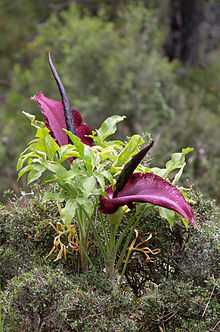Dracunculus vulgaris
| Dracunculus vulgaris (Dragon Arum) | |
|---|---|
 | |
| Dracunculus vulgaris | |
| Scientific classification | |
| Kingdom: | Plantae |
| (unranked): | Angiosperms |
| (unranked): | Monocots |
| Order: | Alismatales |
| Family: | Araceae |
| Subfamily: | Aroideae |
| Tribe: | Areae |
| Genus: | Dracunculus |
| Species: | D. vulgaris |
| Binomial name | |
| Dracunculus vulgaris Schott | |
Female flowers (at the bottom)
Dracunculus vulgaris is a species of aroid in the genus Dracunculus and is known variously as the common dracunculus, dragon arum, the black arum, the voodoo lily, the snake lily, the stink lily, the black dragon, the black lily, dragonwort, and ragons. In Greece, part of its native range, the plant is called drakondia, the long spadix being viewed as a small dragon hiding in the spathe.[1]
It is endemic to the Balkans, extending as far as Greece, Crete, and the Aegean Islands, and also to the south-western parts of Anatolia.[1]
Description
The species is characterized by a large purple spathe and spadix, which has a very unpleasant smell reminiscent of rotting meat to attract flies (Lucilia and others) as pollinators. The large palmate leaves have occasional cream flecks along the veins.
Cultivation
Dracunculus vulgaris has been introduced to northern Europe, and North America, both to the United States, where it is present in the states of Kansas, Oregon, California, Washington, South Carolina, Tennessee, Kentucky, Michigan, the commonwealth of Puerto Rico,[2] and to Canada, where it has been grown in the province of Ontario.
The plant can tolerate some shade but prefers full sun; it can also withstand drought but benefits from a little watering. The plant prefers a humus-rich, well-drained soil.
Notes
- ↑ 1.0 1.1 Dragon Arum at blueworldgardener.co.uk
- ↑ PLANTS Profile for Dracunculus vulgaris (common dracunculus)